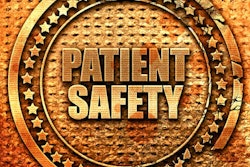
Fresh analysis from clinical MRI practitioners aims to shed light on how scanner design, examination type, and patient age and gender can play a role in scan failures and what can be done to minimize claustrophobia-related patient noncompliance.
"Overall, the incidence of failure to scan in MRI has now dropped below a previously predicted 1%, suggesting improvement, but also scope for further reduction. The benefit of upright scanner designs appears apparent from the data, with an interesting higher incidence in open scanner designs, which was not expected," lead author Darren Hudson, MRI Clinical Lead at InHealth Group in High Wycombe, U.K., told AuntMinnieEurope.com.
The study, published on 9 March in Radiography, was performed as part of a series to provide current understanding around the issues related to MRI and looking at strategies to support emotional control prior to scanning. It draws on operational data to see what the prevalence of failure to scan is which helps to build a picture as to how much of an issue scan-related anxiety and claustrophobia is in MRI and whether further research into support for this is justified.
Claustrophobia accounts for around 30% of incomplete MRIs, which is a significant proportion worth addressing in the current era of rising patient numbers and limited resources, Hudson explained.
Sample details
The research team from InHealth and Exeter University reviewed data from 677,988 MRI scan appointments from between April 2019 and March 2021 across 156 site locations, the majority National Health Service (NHS) facilities, with some private providers. The group analyzed the type of scanner used, patient age, sex, examination area, funding source, attendance, scan completion status, and reasons for incomplete scans.
Overall incidence of incomplete examinations due to claustrophobia was 0.76%. The team also noted that while most scans were performed on conventional systems, those undergoing open scans were over three times more likely to fail a scan due to claustrophobia, while those undergoing upright scanning were half as likely. Furthermore, the likelihood of claustrophobia increased with females, in patients between the ages of 45 and 64, in scans funded by the NHS, and in patients entering the scanner head first or having a head scan.
| Category | Subcategory | Odds Ratio |
| Open and upright scanner vs conventional scanner | Open | 3.72 |
| Upright | 0.59 | |
| Head first entry vs feet-first entry | Head first | 2.06 |
| Head/neck examinations vs knee and below examinations | Head/neck | 8.40 |
| 45-64 years vs all other ages | 45-64 years | 1.63 |
| Female vs male | Female | 1.25 |
| NHS vs non-NHS funded | -- | 1.44 |
The authors also noted that during 2020 and 2021, the overall incidence of claustrophobia rose by 0.1% and incidence of patients not attending rose by 0.2%. These increases could possibly be related to already heightened anxiety among the general population due to the COVID-19 health crisis, the authors noted.
Even though the overall incidence of incomplete scanning was found to be below 1%, this nevertheless has implications for diagnostic delay, potential patient mismanagement, and costs, the authors stated, adding that a further reduction could be achievable with improved scanner design, and awareness of variables that could help identify those patients more at risk of claustrophobia, in turn supporting scan completion via optimized services.
Reasons for failure
Hypothesizing why open scans were, unexpectedly, around three times more likely to fail, while upright scans were half as likely to fail, the authors suggested that while the former seem to have a more panoramic view and wider table, the reality is that the space vertically within the scanner is far less than a modern wide bore system (44 cm vs 70 cm), and therefore can still feel close.
Also unexpectedly, there was a greater incidence of abandonment by males within the upright service. The authors suggested that this could result from men generally having broader shoulders and feeling constrained from the sides.
Furthermore, incidence of abandoned scans doubled when patients were scanned head first compared with feet first in conventional scanners (1.1% vs 0.5%). When comparing head and neck exams with those of the knee and below, the authors saw a 10-fold increase in incidence (1.1% vs 0.1% respectively), with the former procedure eight times more likely to fail.
The highest incidence was seen in the 55- to 64-years-old age group (1.03%) closely followed by the 45- to 54-year-old age cohort (0.96%). Grouping these ages together showed an average incidence of 1% compared to 0.6% in all other age groups. In addition, 60% of cases were female and 40% male, with respective incidence rates of 0.84% and 0.67%. Statistical analysis revealed that female patients are about 1.25 times more likely to suffer from claustrophobia.
Because there is an increased likelihood of scan failure if patients are female and in their 50s, attention needed to be paid to how menopausal status may affect scan completion, the authors stated.
Incidence was higher for NHS patients (0.8%) compared with non-NHS (0.5%), with NHS patients being just under 1.5 times more likely to be unable to complete an exam, the authors stated. They suggested that the potential financial consequence of failing a scan may be enough to motivate private patients to complete an MRI scan, also pointing to how higher levels of deprivation are associated with increasing physical and mental discomfort related to MRI.
Improving services
But how can incidence rates be reduced?
Although scanners are becoming more patient-friendly by design, with shorter acquisition times, studies have shown that as of 2017 in the U.K. over 50% of scanners were still traditional narrow bore (60 cm) systems. Staff training and experience in effectively managing and caring for patients is perhaps the biggest influencer and source of variation in practice that cannot be readily evidenced, the authors noted, pointing to this factor as potentially key to improving scan completion rates.
"As a final part of the series, we have conducted two studies with over 700 patients to gain their insights into their experience of MRI to inform the wider work," Hudson said.
"The first explores the journey of patients attending for MRI, what they consider important when having a scan and what coping strategies they consider effective, while the second one looks at attributes of undergoing a scan to see which aspects drive satisfaction and are considered more important to patients to support their experience overall," he added.
The research helps to provide insights into factors contributing to scan failures, but it is important to keep in mind the individual patient and the impact staff have, which cannot be accounted for from data and the suggested variables alone, according to Hudson.



















